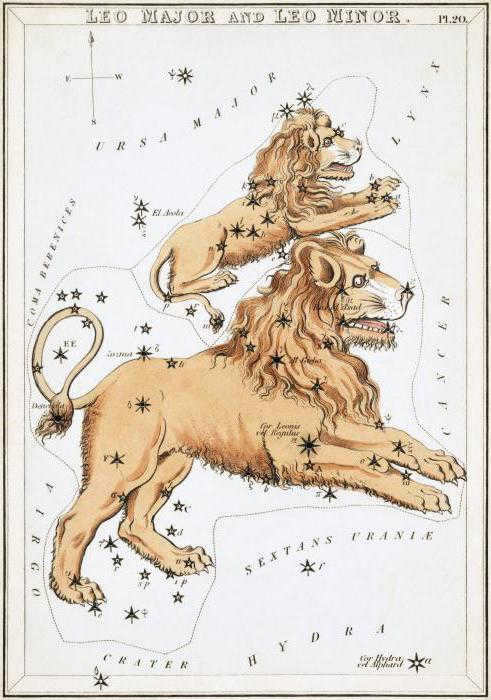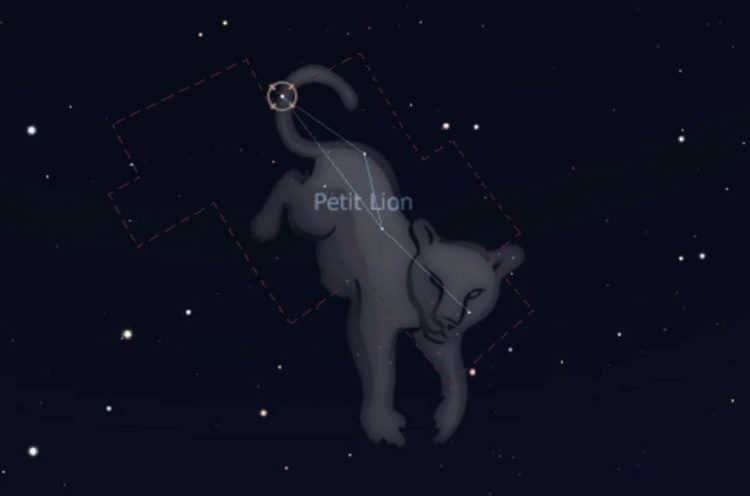
- Constellations
The constellation known as Little Lion can be found in the northern hemisphere of the sky. Covering an area of 232 square degrees, it boasts 34 stars that can be seen without the aid of a telescope. This particular constellation is a favorite among stargazers, as it is a common location for comet sightings.
| Leo Minor |
| LMi |
| Lion cub |
| 9 hours 15 minutes to 11 hours 00 minutes |
| +23° 30′ to +42° |
| 232 square degrees (64th place) |
| none; no stars with magnitude less than 3 |
Main stars in the Leo Minor constellation
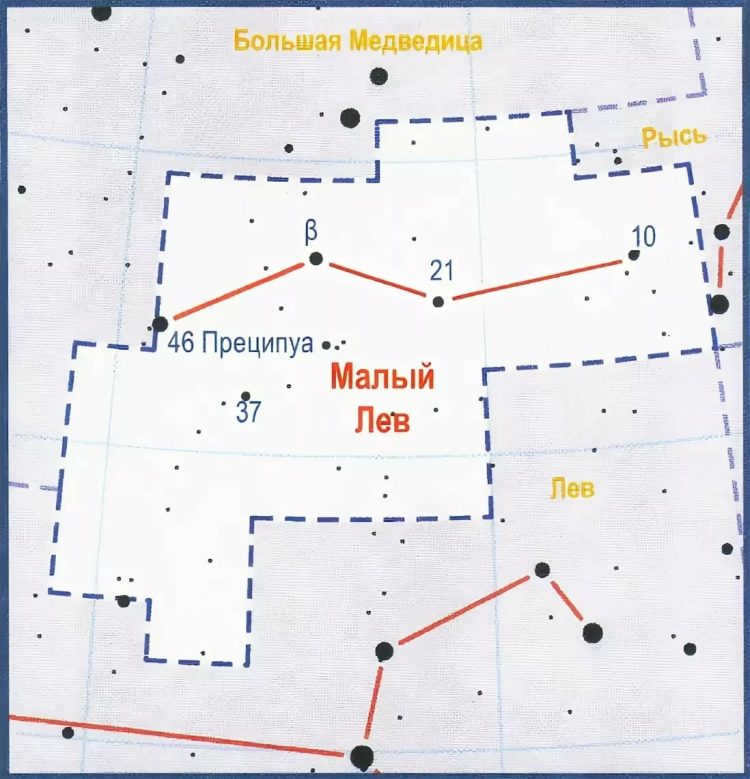
Precipua (46 Leo Minor)
Precipua (46 Leo Minor) is the most luminous celestial body in the constellation of Leo Minor. It belongs to the K0+III-IV star classification, which signifies its transitional state between a subgiant and a giant star. It has an apparent visual magnitude of Z.8Z and is located at a distance of 94.9 light-years.
This star is 2.4 times more massive than the Sun and has a radius 6.4 times larger than that of the Sun.
Originally, the star was supposed to be designated as “alpha,” but the astronomer Francis Bailey, who cataloged it, decided to exclude it. The name “Precipua” comes from the Latin word “praecipua,” meaning “chief star of the Little Lion.” It is sometimes also referred to as Leo Minor.
Beta Minor Leo is a binary star system consisting of a yellow giant subgiant (G8III-IV) and a yellow-white subgiant (F8IV). This celestial object holds the distinction of being the second most luminous star within the constellation Leo Minor.
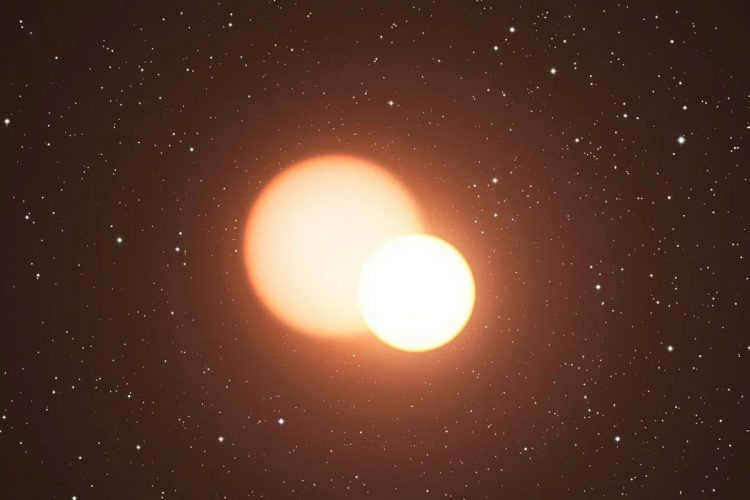
The star that shines the brightest in the night sky in the constellation of Leo is Z6 times more luminous than our Sun. It is also twice as massive and has a radius that is 7.8 times larger. Its companion star is 5.8 times brighter, has a radius twice as large, and has a mass equivalent to 1.Z5 times that of the Sun. The two stars have visible visual magnitudes of 4.40 and 6.12, respectively. They are located at a distance of 146 light-years from Earth.
21 Leo Minor
21 Leo Minor is a white dwarf (A7V) with a visual magnitude of 4.49 and a distance of 92.1 light-years. It is the third brightest dwarf in the constellation.
10 Leo Minor
10 Leo Minor is a yellow giant (G8III) with a visual magnitude of 4.60. Z7 of the Little Lion is a yellow supergiant (G2.5IIa) with a magnitude of 4.69 and an absolute magnitude of -1.84. It is situated at a distance of 580 light-years.
20 Leo Minor
20 Leo Minor is a binary star system located approximately 49.1 light-years away from Earth. The system consists of a yellow dwarf star (GZ Va) and an aging red dwarf star (M6.5), which are separated by a distance of 14.5 arc seconds.
11 Leo Minor
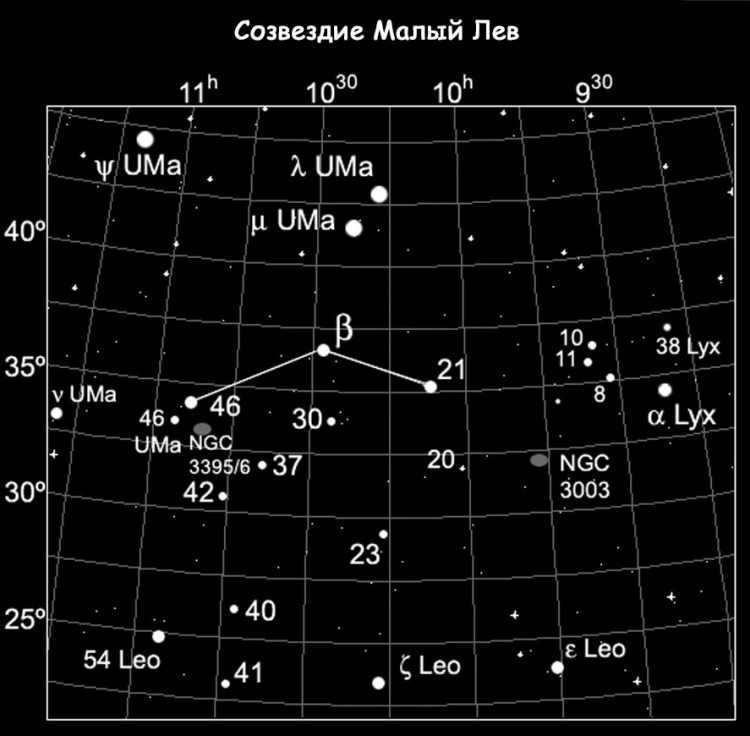
11 Leo Minor – A binary star system located Z6.5 light-years away. The primary star is a G8V yellow dwarf with a visual magnitude of 5.41.
Although it is more massive than the Sun, it is less luminous. This star exhibits characteristics of an RS Canum Venaticorum variable, which is a close binary system with an active chromosphere that produces large star spots causing changes in brightness. The luminosity of this star varies by 0.04 magnitudes. The secondary star is an M5V red dwarf with an apparent visual magnitude of 1Z.0.
HD 8788Z
HD 8788Z is an orange dwarf star (K0V) that has a visual magnitude of 7.56 and is located 59 light-years away. This star is estimated to be approximately 9.8 billion years old.
On August 1Z, 2009, an exoplanet known as HD 8788Z b was discovered in orbit around this star. It has a long orbital period of 7.5 years.
Noteworthy Celestial Objects
1. NGC 2859: The Fascinating Lenticular Galaxy.

The NGC 2859 galaxy can be found in the vicinity of the Lynx constellation. It is situated at a distance of approximately 83 million light years away from our planet. The galaxy’s brightness is measured at 10.7m, while its surface brightness is recorded at 14m. In terms of size, it spans approximately -4.6′ × 4.1′. The image displayed above showcases a prominent star in close proximity to the galaxy, which possesses a magnitude of 7 and is not visible to the naked eye.
To locate NGC 2859 with ease, it is recommended to begin at the brightest star in the Lynx constellation, known as α Lyn, and slightly rotate the telescope tube counterclockwise.
2. NGC 3245: A Lenticular Galaxy
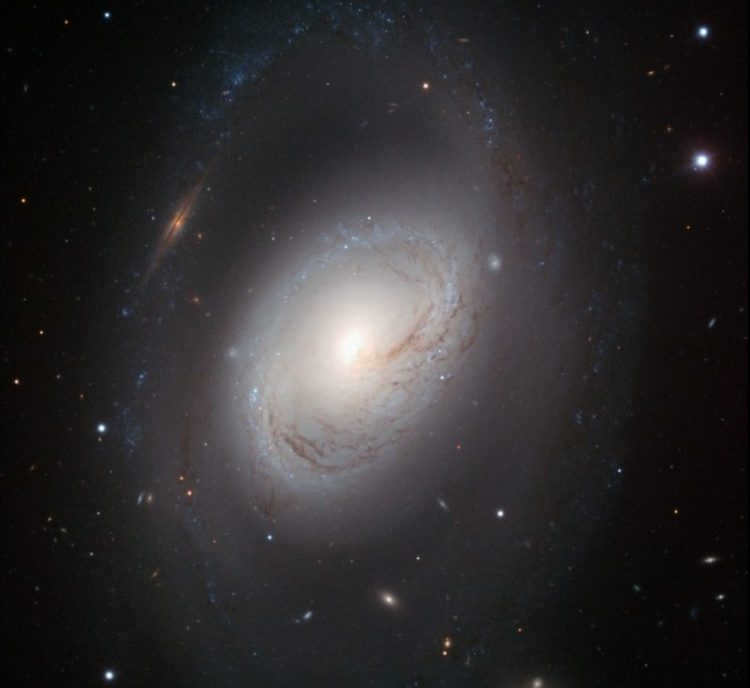
The constellation Leo is home to another lenticular galaxy, NGC 3245, which sits on the border. William Herschel discovered this galaxy in 1785. It has a visible magnitude of 10.7m, a surface brightness of 12.5m, and measures 3.2′ × 1.8′.
Getting to this galaxy is no easy feat. It will require multiple attempts and a telescope with a main mirror diameter of at least 200 mm. Begin by locating a few stars with a magnitude of 4-5, then gradually lower the telescope tube.
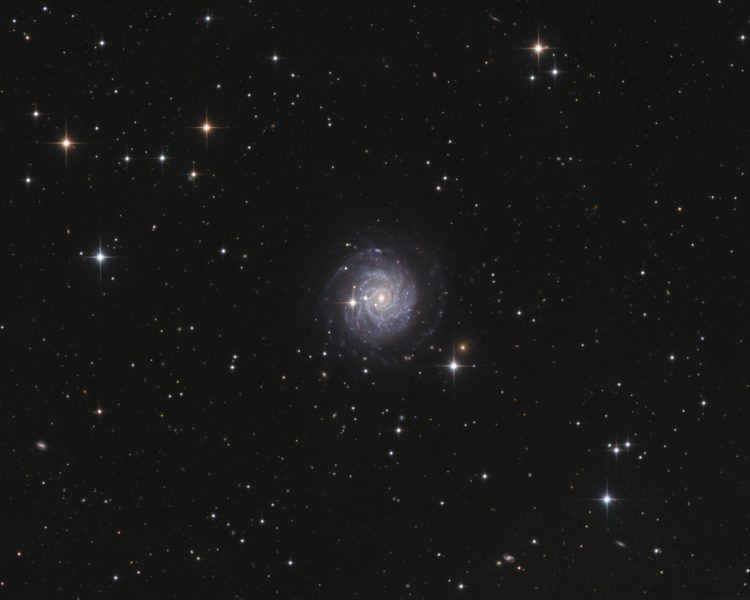
NGC 3344, a spiral galaxy of the Sc-type, is situated 22.5 million light-years away. It holds the title of the brightest galaxy in the constellation of the Little Lion. With a magnitude of 10m and dimensions of 7.1′ × 6.5′, it is easily visible even through a 150 mm telescope. When observing it with a telescope of 250+ mm, one can even spot its spiral arms. Due to its convenient position for observers, this dip-sky object has become a favorite in the constellation.
In front of the galaxy, one can observe three “bright” stars forming a triangle. Above the galaxy, a careful examination using a finder or a wide-angle lens at minimum magnification reveals a cluster of faint stars tightly packed together. These stars can serve as an excellent guide for those searching for southern galaxies in the constellation.
4. NGC 3414: The Spectacular Lenticular Galaxy
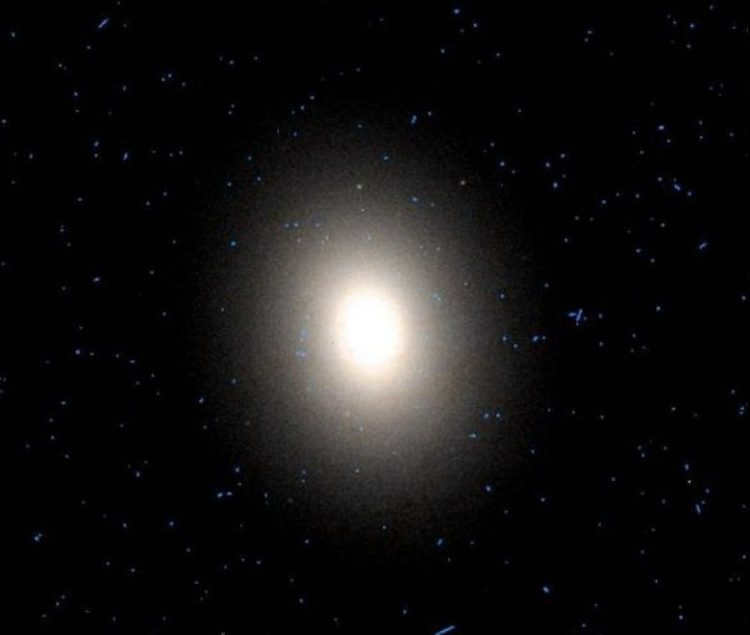
The lenticular galaxy NGC 3414 is almost at the point of being as bright as an 11 star magnitude. It has a size of 3.5′ × 2.6′ and a center that is intensely saturated, which can be observed using a telescope with an aperture of 200 mm or larger. Naturally, it will require some additional effort to locate and observe it.
5. Spiral galaxy NGC 3486
NGC 3486, a spiral galaxy of the SBc type, is located 27.4 million light-years away from the Solar System and can be observed using amateur and semi-professional telescopes. This galaxy has a brightness of 10.3m and measures 7.1′ × 5.2′. Positioned towards us, NGC 3486 showcases a prominently bright and concentrated nucleus.
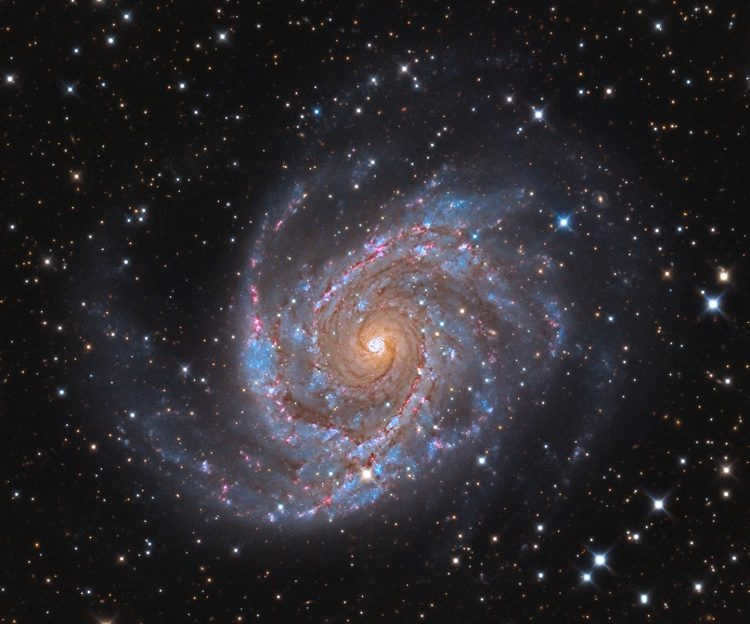
One possible search option is to start from the two bright stars (3-3.5 sidereal magnitudes) ξ CMa and ν CMa in the Big Dipper and gradually descend and turn the telescope tube clockwise.
Finding a constellation in the sky
The constellation is located next to the Big Dipper, Cancer, Lynx, and Leo. To find it, begin with the well-known asterism – the Big Dipper. Minor Leo can be found between it and Leo, with Lynx to the right.
The constellation can be seen in latitudes ranging from -45° to +90°. The best time for observation is in March and April.
Little Leo can be clearly seen throughout Russia, but its faint stars are better observed with binoculars.
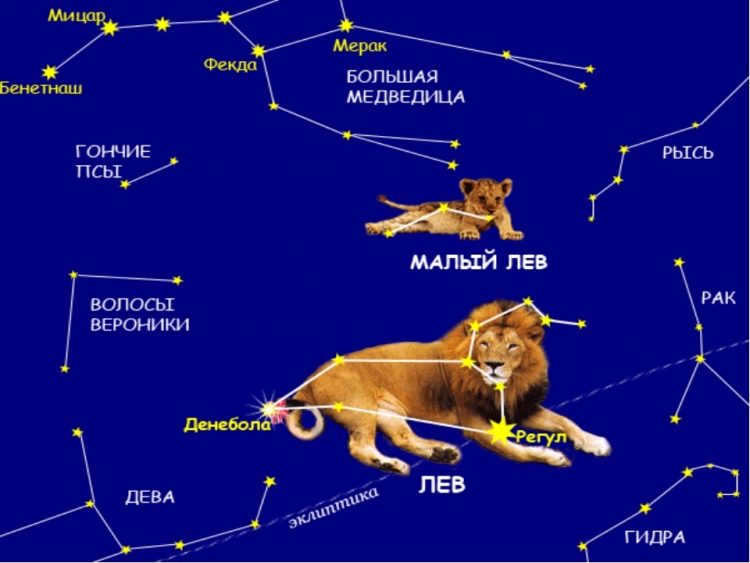
During autumn, Leo Minor is not positioned very high above the horizon in the northeastern part of the sky. The primary point of reference for locating it is the Big Dipper. The constellation of the Little Lion can be found below it. To the right and slightly above Leo Minor is the constellation of Gemini. If you observe the sky at midnight, you will be able to see the rising head of Leo, the larger lion, just beneath Leo Minor.
In winter, Leo Minor rises high above the horizon and can be seen in the southeast. The Big Dipper moves above and to the left of Leo Minor during this time. Additionally, if you locate Leo Minor, it will also guide you towards the constellation of Leo, which is positioned below Leo Minor.
In the summer, the Lesser Leo reaches its lowest point above the horizon on its northwestern side. Above it, you can see the Big Dipper. On the left side of the Lesser Lion, you’ll find the constellation of the Magpie, while on the right side, the bright star Capella, also known as the Ascendant, shines.
The Origins of Leo Minor Constellation
The constellation Leo Minor was first introduced to astronomical maps by Jan Hevelius, who included it in his Uranographia published in 1690. On most astronomical atlases, Leo Minor is depicted as lying in the hind legs of the Big Lion.
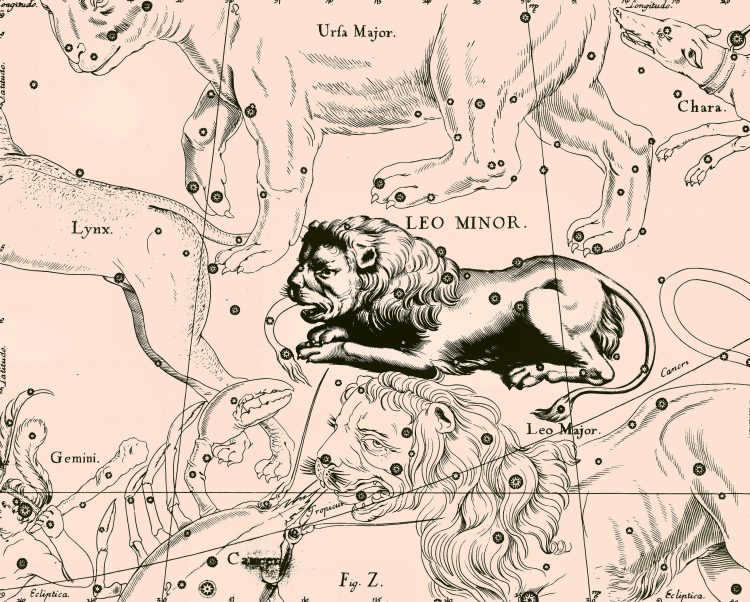
Leo Minor does not have a star named α, but it does have β. Hevelius did not assign labels to the stars in the constellations he discovered; these were later added by Francis Bailey for Leo Minor. The second brightest star was named beta, as is typical, and the brightest star (46 LMi) was mistakenly left unnamed. There are no other stars in this constellation that are designated with Greek letters, but 46 Leo Minor is sometimes referred to by the Latin letter o. This suggestion was made by Johann Bode in his 1801 article.
The constellation Leo Minor was not recognized by the ancient astronomers. Aratus placed it as part of the unformed section of the Big Dipper, while Ptolemy included it in the constellation Leo.
Leo Minor resembles a young lion cub lying beside the constellation Leo. There are no specific myths associated with this constellation.
Everyone is familiar with the famous feat of Hercules, when he strangled the Nemean lion with his bare hands. Following this, he began to wear the lion’s skin as a cloak, which he wore throughout his life and even on his funeral pyre. This lion is represented in the sky as the constellation Leo.
Not many people are aware of the fact that in his youth, prior to his service under Eurystheus, Heracles managed to slay the Cypheron lion on Mount Cypheron, and there is a possibility that he even donned its skin! It is conceivable that this lion, considered to be the “younger sibling” of the Nemean lion, has its presence depicted in the celestial map as the Lesser Lion.

Little Lion constellation is situated in the sky’s northern hemisphere. It holds the 64th position among all areas, covering an expanse of 232 square degrees. This region borders the Big Dipper, Leo, Cancer, and Lynx constellations.
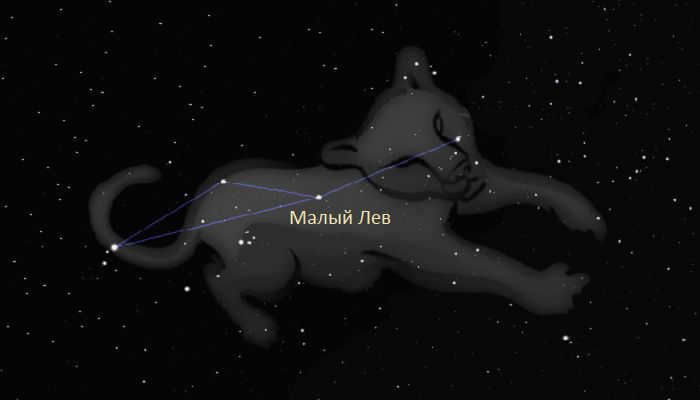
Interestingly, the constellation Leo Minor is a relatively new and contemporary part of the night sky. It is believed to have been introduced in the 17th century by Jan Hevelius, who included it in his star atlas. However, Hevelius did not label the individual stars within the constellation. Furthermore, the constellation does not feature the star Alpha. In fact, only one object within Leo Minor is designated with a recognizable Greek symbol.
Surprisingly, the stars within Leo Minor were not officially designated until almost 150 years later by Francis Bailey in 1845. These designations have remained in place to this day.
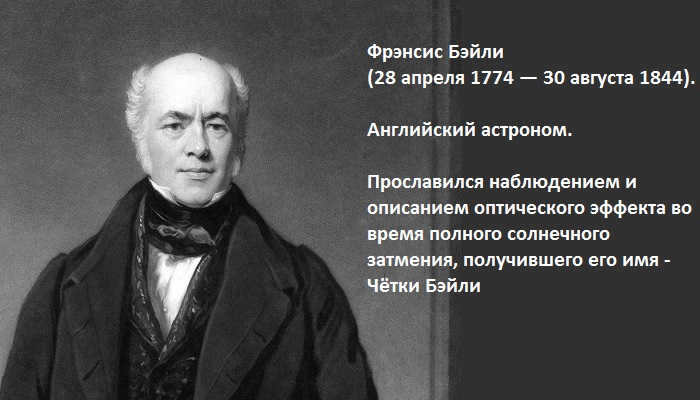
The stars that make up the constellation Little Leo
According to astronomers’ calculations, there are a total of 34 stars that can be seen with the naked eye in this constellation. However, none of them are brighter than the 3rd magnitude.
It is worth noting that the constellation Leo Minor does not have an Alpha star.
Therefore, the brightest star in the 46 Little Leo is currently going through a process of evolution from being a subgiant to becoming a giant. This star is also known as Precipua, which means “main”. It is considered a strong candidate for the title of Alpha star and has an apparent magnitude of 3.83.
In second place, we have Beta, which is a binary system with a brightness of 4.22.
And finally, we have 21 Leo Minor, which is a white dwarf star with an apparent luminosity of 4.49.
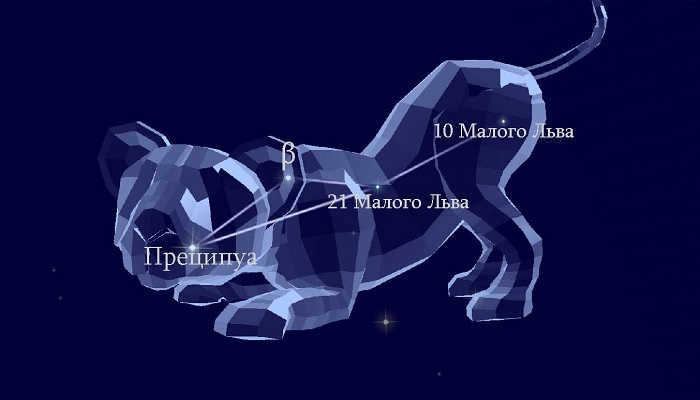
One star in the constellation Leo Minor that stands out is 10 Leo Minor, a giant star with a yellow color. It has a magnitude of 4.6.
Another notable star in Leo Minor is 37 Leo Minor, a yellow supergiant with a brightness of 4.69.
Interestingly, both 20 and 11 Little Leo are binary star systems composed of dwarf components, with an average visibility value of 5.4. It is worth mentioning that 11 Leo Minor is the closest to us.
Another star to mention is HD 87883, an orange-colored dwarf. It has an exoplanet in its orbit and has a visual magnitude of 7.56.
What are the contents of the Little Leo constellation?
The most fascinating celestial object within the constellation is the Hanni object. It is a rare and enigmatic type of object in the Universe known as a quasar ionized echo. Discovered by Hanni van Arkel in 2007, this echo provides a reflection of past events, similar to how an echo carries sound.
It is believed that the Hanni object is the remnants of a galaxy, reflecting the radiation emitted by a quasar in the past. However, some scientists propose a different theory, suggesting that a supermassive black hole resides at the center of this echo, emitting a powerful jet of energy. This energy interacts with gas and dust, producing light and giving the object its illumination and brightness.
Additionally, the shape of the ionized echo resembles that of a raindrop. Furthermore, there is evidence of star formation occurring in the surrounding region.
Adjacent to the Hanni Object lies a massive spiral galaxy known as IC 2497..
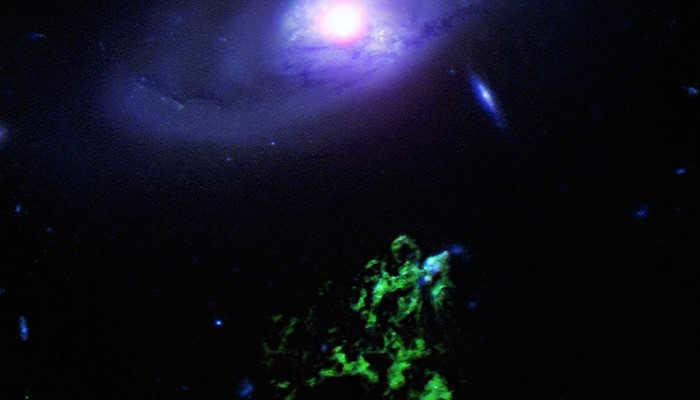
The constellation Little Lion features various other star systems:
- There are interacting galaxies, such as the Arp 107 galaxies, which are in the process of merging with each other;
- There are spiral galaxies, including NGC 3003, NGC 3021, NGC 3344, NGC 3486, and NGC 350;
- There are quasar-like galactic structures known as the Seifer structures, which include 3С 223 and 3С 234;
- There is also a lenticular galaxy with a junction called NGC 2859.
Leo Minor is home to the meteor stream known as the Leo Minorids, which is associated with the comet C/1739 K1.
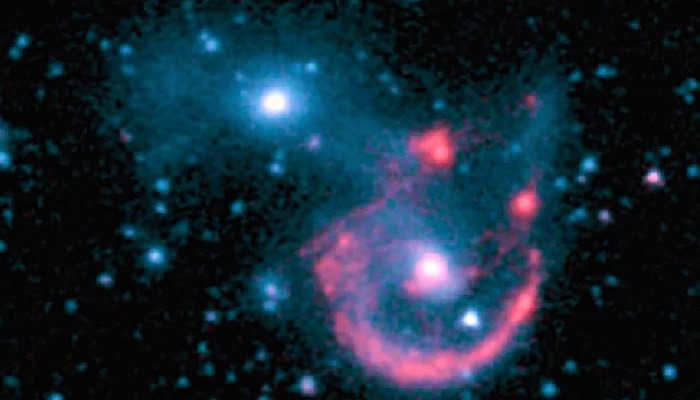
Noting
It has been discovered that the region’s visibility decreases between a latitude of +90 and -48 degrees. Therefore, individuals residing in Russia have complete access to the Small Lion constellation. However, it is advisable to dedicate the months of March and April to observing it, as these months offer the most favorable conditions.
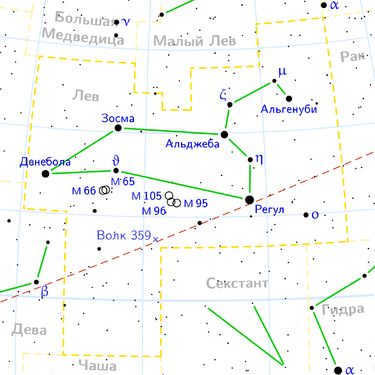
Leo (Latin Leo) is a constellation in the northern hemisphere of the sky, situated between Cancer and Virgo.
Overview
The arrangement of the prominent stars closely resembles a lion lying down, with its head and chest forming the well-known asterism called the “Sickle,” which resembles a reflection of a question mark.
The bright blue-white star Regulus (α Leo) at the bottom of this sign represents the “king” in Latin. It is also known as the “Heart of the Lion” (Cor Leonis). Regulus is 160 times more luminous than the Sun and its high apparent luminosity (1.36 magnitude) is due to its proximity to us (85 sidereal years). Among the first magnitude stars, Regulus is the closest to the ecliptic, making it often covered by the Moon.
The star Denebola (β Leo), which translates from Arabic as “lion’s tail,” is located at the rear of the beast’s figure. It has a brilliance of 2.14 sidereal magnitude and is only 43 sv. years away.
The golden-yellow star Algieb (γ Leo), representing the “lion’s mane,” is located at the base of the lion’s head. It is a close visual double with a stellar magnitude of 2.0.
Among the distant objects in this constellation, you can find some fascinating spiral galaxies such as M 65, M 66, M 95, and M 96. Additionally, there is the elliptical galaxy M 105, which is located near the last two spiral galaxies. The apparent brightness of these galaxies ranges from 8.4 to 10.4 star magnitudes.
Asterism Sickle
The asterism known as Sickle consists of six stars within the constellation, namely α (Regulus), η, γ (Algieba), ζ, μ, and ε (Algenubi). When these stars are connected, they form a shape that resembles a sickle or a mirrored question mark.
Observation
Typically, the Sun is present in the constellation between August 10 and September 15 [1]. The optimal circumstances for observing it occur in February and March. It can be seen across the entirety of Russia.
The radiant of the Leonids meteor shower is situated in the constellation of Leo. This shower is formed as a result of the fragmentation of the Tempel-Tuttle comet, and it is observed in the middle of November.
Historical Origins
The history of the Leo constellation dates back over 5000 years to the time of the ancient Sumerians. It was already well-known and recognized by this civilization. The constellation was also documented in Claudius Ptolemy’s Almagest catalog, which was a comprehensive catalog of the stars and constellations in the sky. In classical mythology, Leo is often associated with the Nemean monster, a fearsome creature slain by the hero Hercules. The significance of Leo can also be seen in ancient Russian manuscripts from the 11th century, where it is mentioned in a text by A. Budilovich titled “XIII words of Gregory the Theologian in Old Slavonic translation…”. [2]
Further Reading
Additional Information
- ↑The Zodiac Constellations (English) . Astronomy Online. Retrieved from the original source on November 9, 2012.Accessed on November 7, 2012.
- ↑Dictionary of the Russian Language from the 11th to 17th Centuries. Volume 8 / Chief Editor F. P. Filin. – Moscow: Nauka, 1981. – P. 183.
- Lev. wikisky.org. Archived from the original source on November 9, 2012.Checked November 5, 2012.
- Lev. Astromyth. Archived from the original source on November 9, 2012.Checked November 5, 2012.
1 (κ, Al Minliar al Asad) – 2 (ω) – 3 – 4 (λ, Alterf) – 5 (ξ) – 6 (h) – 7 – 8 – 9 – 10 – 11 – 12 – 13 – 14 (ο, Subra) – 15 (f) – 16 (ψ) – 17 (ε, Algenubi)
The Leo constellation guide, which is summarized in this article, will provide you with a wealth of interesting information about it.
A tale of the Leo constellation
The Leo constellation has been recognized by the Sumerians over 5,000 years ago and was also documented in the Almagest catalog by Claudius Ptolemy. It is commonly illustrated as the head of a lion with a flowing stream of water emanating from its mouth.
Description of the Lion constellation
Situated between Virgo and Cancer, the Leo constellation can be found in the night sky. Its body is formed by four prominent stars – alpha, beta, gamma, and sigma – which create a shape resembling a trapezoid. The arrangement of smaller stars forms the “lion’s head.”
The brightest star in the constellation is Regulus, a blue-white star. It is often hidden by the Moon due to its proximity. Denebola and Algieba are the second brightest stars. Another intriguing celestial object within Leo is the star Wolf 359, which is a small, faint red dwarf.
The Mythical Tale of the Creation of Leo Constellation
This story originates from the legendary feat of Hercules, who was commanded by King Eurystheus to accomplish it. Within the king’s domain dwelled a massive lion adorned with impenetrable skin. This creature wreaked havoc by slaughtering livestock and humans alike. Thus, Eurystheus dispatched Hercules to vanquish this formidable lion.
The hero fashioned a colossal club from a wild olive tree. He uprooted the tree, stripped it of its branches and twigs. Additionally, Hercules equipped himself with arrows and a bow, then set off to confront the lion.
A fierce battle ensued. The lion’s robust hide proved impenetrable, and strikes from the olive club only served to further enrage the beast. Hercules had no choice but to rely on his bare hands to overpower the creature: he strangled it. Consequently, both people and animals were saved, and justice prevailed.
Hercules took the lion and carried it on his shoulders to King Eurystheus. When the king saw the dead beast, he was filled with fear and ordered the hero to leave the royal court. From then on, all communication between the king and Hercules was done through messengers. Hercules kept the lion’s skin as a trophy, using it as a durable and stylish cloak.
The Lion Leo is a zodiacal constellation that can be found in the northern hemisphere of the sky. It is situated between the constellations of Cancer and Virgo. The Sun enters Leo on August 10th.
Leo covers an area of 947 square degrees on the star chart, making it one of the largest constellations, ranking 12th in size. Its neighboring constellations include the Big Dipper, Little Leo, Veronica’s Hair, Virgo, the Bowl, Hydra, Cancer, and the Sextant.
The Sumerians were already familiar with the constellation of Leo 5,000 years ago.
The constellation Leo was associated by the ancient Egyptians with the seasonal manifestations of nature. During the time when the constellation of the Lion was at its zenith in the night sky (March, April), it was the hottest period in ancient Egypt. The fertile Nile valley even dried up and the soil cracked due to the unbearable heat. During this time, the desert transformed into a kingdom of lions at night. This annual occurrence led the ancient Egyptians to name the visible part of the sky at this time after the king of beasts.
On the cat encyclopedia located at http://www.сайт, there is a classic myth that connects the name of the constellation Leo to Hercules’ first feat – the triumph over the Nemean lion.
The constellation Leo can be seen in latitudes ranging from +84° to -56°.
The optimal time for observing Leo in Russia is during February and March.
The most brilliant celestial bodies in the constellation of Leo are Regulus (α Leo), Denebola (β Leo), Zosma (δ Leo), Algenubi (ε Leo), and Algieba (γ Leo). These stars are arranged in such a way that they form the Sickle asterism, which bears a striking resemblance to a mirrored question mark.
Johann Bode’s 1801 publication, “Uranographia,” is accompanied by stunning hand-colored illustrations.
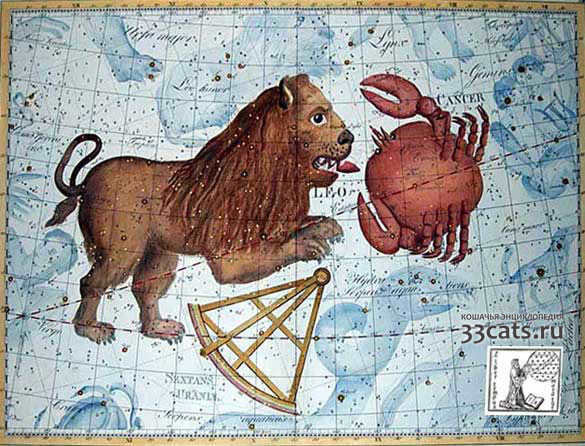

Within Leo’s constellation, there exists a plethora of captivating binary stars, fluctuating stars, and galaxies; nevertheless, they are solely visible through the utilization of high-powered telescopes.
The star that shines the brightest in the constellation of Leo is known as Regulus (α Leo). Regulus (α Leo) gets its name from the Latin word “rex,” which means “king,” because according to legends, great kings were believed to be born under the sign of the Leo constellation. It is also sometimes referred to as the “Heart of the Lion” (Cor Leonis). Regulus is located approximately 85 light years away from Earth. It is about three times larger than the Sun and has a surface temperature of 14,000 K. Regulus shines with a luminosity that is 160 times greater than that of the Sun. Among the stars with a first magnitude, Regulus is the closest to the ecliptic, which means that it is often covered by the Moon.
Behind the figure of the beast, you can find the star known as Denebola. Denebola, which translates to “tail of the lion” in Arabic, has a luminosity of 2.14 star magnitude and is located only 43 light years away.
Located at the bottom of the “lion’s head” is the golden-yellow Algieb (γ Lion). Also known as Algieba (γ Leo), this star is referred to as the “lion’s mane.” It is a close visual double of a star with a magnitude of 2.0.
One of the most commonly discussed features in the Leo constellation is the group of three galaxies known as the Leo triplet: NGS3628, M66 (NGS3627), and M65.
The spiral galaxy NGC 3627, which is listed as number 66 in the catalog created by the French astronomer Charles Messier (1730 – 1817), is also commonly referred to as M66.
The largest galaxy in the triplet, NGC 3627, is situated approximately 35 million light years away from Earth. The central core of NGC 3627 and the dark dust clouds that run along its spiral arms are clearly visible in the image captured at the observatory in Chile. Additionally, the arms display an irregular structure and appear to be slightly elevated in comparison to the galaxy’s main plane. Astronomers believe that this asymmetry is likely a result of gravitational interaction between NGC 3627 and its neighboring galaxies, M 65 and NGC 3628.
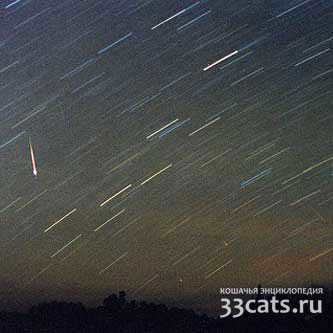
Leonids meteor stream
The radiant of the Leonid meteor shower is located in the Leo constellation and is created by the fragmentation of the Tempel-Tuttle comet. This shower is most active from November 15 to 19, with its peak occurring on November 17, when approximately 10 meteors can be seen per hour.
The Leonid meteor particles have a closed orbit around the Sun, but they are not evenly distributed in the orbit. Instead, they form a concentrated cloud in one part of the orbit. When the Earth crosses this part of the Leonid stream’s orbit, it experiences a phenomenon known as “star showers”.
The first recorded observation of a Leonid star shower was in 1799, when approximately 30,000 meteors were observed in an hour. Similar star showers from the Leonids were observed in 1833, 1866, and 1933. The most recent Leonid star shower occurred in 1966 and was a spectacular event with a record-breaking 144,000 meteors observed per hour!
These “star showers” from the Leonids occur approximately every 33 years.
The constellation Leo is located adjacent to the constellations Virgo and Cancer. It is the 12th largest constellation and contains a total of 87 stars.
The Lion constellation is linked to the legendary battle between Hercules and the lion. This fierce predator struck fear into the hearts of Earth’s inhabitants, but Heracles came to their aid. The hero bravely strangled the lion, and to honor his extraordinary feat, Zeus arranged the stars in the sky in a unique pattern, giving birth to the Lion constellation. Astronomers believe that the lion is depicted in a jumping pose.
In close proximity to the Lion, you can find the renowned constellation of the Great Bear.
Among the many stars within the Lion constellation, there is one that shines the brightest – Regulus. Although this star is occasionally overshadowed by the Moon, it remains one of the most luminous stars in the night sky. Regulus is often referred to as the heart of the lion.
Denebola, also known as the tail of the lion, can be found at the posterior region of the constellation.
Correspondingly, the star Algieba represents the lion’s mane.
If you want to catch a glimpse of the Leo constellation in all its magnificence, the best time to do so is in February or March. To locate it, simply search for the Ursa Major constellation. Legend has it that if you mentally tilt the bucket of the constellation to pour water, it will cascade onto the lion’s head, guiding you to the wild predator. Just above the Leo constellation lies another constellation known as the Lesser Lion.
The history of the Leo constellation is one of a kind and cannot be replicated. It is uncertain how much longer individuals will have the opportunity to witness this awe-inspiring spectacle.
Alternative Choice
The Lion constellation is linked to an ancient Greek legend recounting the initial triumph of Heracles. As per the myth, Zeus, the father of Heracles, created a new constellation in the heavens in commemoration of his son’s victory over the Nemean lion, thereby giving rise to the Leo constellation.
Leo is considered by scientists to be one of the oldest constellations. According to archaeologists, this constellation was already known in Mesopotamia (modern Iraq and northeastern Syria) about 6 thousand years ago. Babylon (also modern Iraq), Persia (modern Iran), and Ancient Egypt were also aware of this constellation. In all these states, the Lion constellation appeared in various legends. For instance, in Ancient Egypt, it was believed that powerful rulers were born under the sign of Leo, when the constellation held a prominent position in the sky. As a result, the brightest star in Leo was named Regulus, which means “king” in Latin. In Arabic, the star is known as the “heart of the lion”.
Regulus, a star with a blue-white hue, has a size 3.5 times greater than the Sun and shines with a brightness that is 160 times stronger. This particular star holds the title of being the most luminous in its constellation and the 22nd brightest in the entire night sky. Alongside Regulus, other stars in the Leo constellation such as Denebola, Zosma, Aljeba, and Algenubi also emit a significant amount of light. Aljeba, with its golden-yellow hue, is often referred to as the lion’s mane, while Denebola is known as the tail. Moreover, the constellation of Leo is home to not only double and triple stars but also various galaxies.
Furthermore, the constellation Leo features an outstanding asterism known as the Sickle. An asterism is a distinct group of stars that has its own designation but does not encompass all the primary stars within a constellation. Examples of asterisms include Orion’s Belt, Orion’s Sword, and the Pleiades. As its name suggests, the Sickle asterism resembles a sickle shape and is composed of six stars. Three of these stars serve as the foundation for the Leo constellation – Regulus, Aljeba, and Algenubi.
Leo is among the twelve zodiacal constellations (thirteen if you count Serpentor), situated in the northern hemisphere between the Cancer and Virgo constellations. Additionally, neighboring constellations include Veronica’s Hair, the Lesser Lion, the Big Dipper, the Bowl, the Sextant, and the Lynx.
It would be a pity not to know how to locate the constellation Leo in the night sky after learning so much about it. Luckily, it is quite simple to find. First, locate the Big Dipper constellation, which is made up of seven stars that resemble a bucket with a handle. Now, imagine water pouring out from the ladle’s edge, and it will fall right behind the Lion’s neck. Thankfully, the Leo constellation is easily visible across our country, with the best time to observe it being from February to March. Once you become proficient in finding Leo in the sky, you can use it as a guide to locate other constellations. Who knows, it might even ignite a passion for astronomy.
Grades 2, 5, 6, 11. Environment
- The first mention of Voronezh in historical chronicles dates back to 1177, when it was mentioned in relation to the events of that year. After suffering a defeat, Prince Yaropolk of Ryazan fled to a place known as Voronezh. However, it is widely accepted that Voronezh was officially founded in 1571.
- An 8th grade report on the invention of turbines. A turbine is a type of motor that is capable of rotating, typically at high temperatures, using a gas or liquid as its source of power. A water mill is an example of a turbine.
- A 9th grade chemistry report on alkali metals for kids. Alkali metals are a group of common organic substances that include metals with similar atomic structures and properties. This group includes lithium, potassium, cesium, sodium, and rubidium.
Most constellations differ significantly from their namesakes. Take, for instance, the constellation Pegasus, where it’s quite challenging to discern the legendary winged horse, or the constellation Lynx, which doesn’t resemble a forest predator.
However, Leo is a different story. With just a touch of imagination, one can easily locate and identify the king of beasts within the arrangement of its brightest stars. The shape of this constellation is so straightforward and evocative that it’s instantly ingrained in memory. As a result, Leo is frequently utilized as a guide to locate neighboring constellations that lack such distinctiveness.
So, how exactly can one locate the Leo constellation in the vast expanse of the starry sky?
Firstly, let’s come to an agreement about the specific time during which we will embark on our search. It would be most convenient to conduct our search in the evening as opposed to the nighttime or early morning. During the nighttime, we are typically asleep and in the morning, we are usually preoccupied with our studies or work.
In the evenings, we can begin observing the Leo constellation starting from the month of February. During this period, Leo becomes visible in the eastern sky shortly after dusk and remains observable until late in the evening towards the southeast.
During the evenings in February, the Leo constellation rises later in the evening towards the eastern horizon. See the accompanying figure from Stellarium.
A distinguishing characteristic of Leo that sets it apart from other constellations is the presence of a large trapezoid formed by four stars. This trapezoid is approximately the same size as the dipper in the Big Dipper constellation, and the brightness of the stars in both these celestial figures is quite similar. The brightest star in the Lion Trapezium is located in the lower right corner, known as Regulus. Regulus is not only the main star of the constellation, but also the 20th brightest star in the entire night sky.
You don’t need any specific landmarks to locate the trapezoid – it will immediately catch your attention if you simply look in the correct direction! As mentioned earlier, the trapezoid can be seen in the eastern and southeastern skies during the evenings in February, but it is important to note that it is tilted.
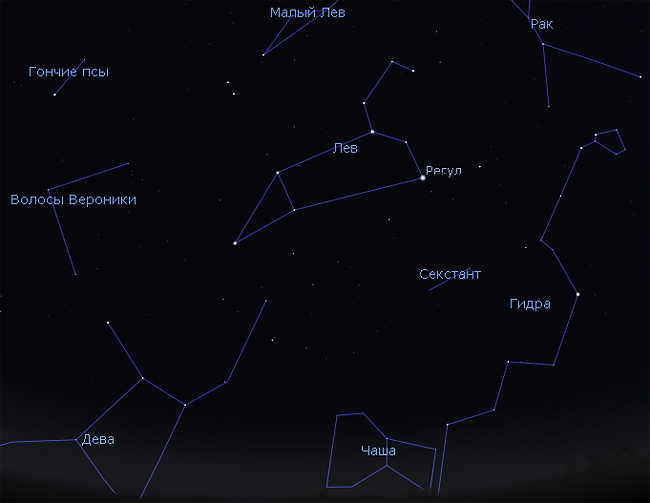
The constellation Leo can be seen in the southeast of the evening sky during the month of March. The best time to observe Leo is in the spring, particularly in the first half of the season. In March, Leo is visible in the southeast and is positioned halfway between the horizon and the zenith.
As we move into April, Leo becomes even more prominent in the southern sky. It becomes the dominant constellation of the spring sky, as the surrounding constellations are relatively faint. Only two stars, Arcturus and Spica, shine brighter than Regulus in the spring sky. However, the constellations associated with these stars, Capricorn and Virgo, are also quite dim. The trapezium shape of Leo is easily recognizable in April and can be located easily in the sky.
By the way, in case you have any hesitation about your ability to locate the Leo constellation in the sky independently, remember this helpful tip: Leo can be found below the handle of the Big Dipper! With this valuable information in mind, you will easily spot the Leo constellation at any given time, as long as it is visible above the horizon.
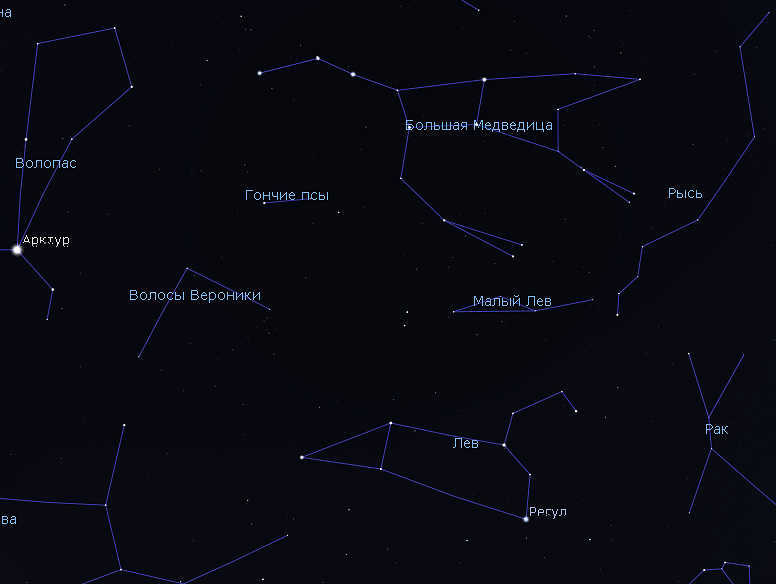
During the spring season, the Big Dipper reaches its highest point in the sky, while the Leo constellation can be observed below it in the southern part. Image: Stellarium
As the month of May progresses, the evenings become darker. In the southwest, the Leo constellation becomes visible and remains in the sky for a short period before disappearing below the horizon.
Now, you might wonder: Why was the Leo constellation named after the king of animals instead of being called Trapezium?
If you happen to come across the Leo constellation in the night sky, make sure to take a moment to observe it closely. Just above the right side of the trapezoid shape that forms the constellation, you will likely notice three additional stars. These stars, along with Regulus and the star Algieb (located at the upper right corner of the trapezoid), create a distinctive shape that resembles a question mark turned in the opposite direction. This shape, due to its similarity to an ancient farming tool, has been traditionally referred to as the Sickle by many people.
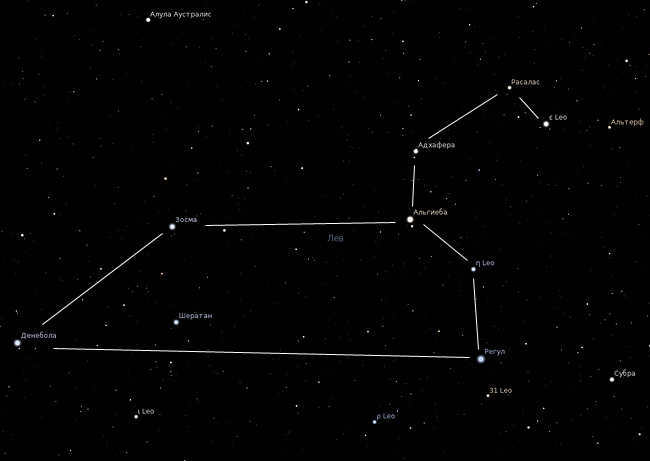
The Asterism Sickle of the Lion is identified by the presence of Regulus at the handle, while the sickle itself is marked by the stars Algieb, Adhafera, Rasalas, and the epsilon of Leo. In ancient maps, this region was depicted as the forelegs, chest, and head of a reclining predator. This image is captured in the Stellarium figure.
Interestingly, this figure also reveals the presence of both the chest and head of the Lion. It appears that the predator is lying down with its head raised, gazing towards the western horizon.
On a dark and clear night, you can also observe the Lion’s tail in the sky. However, we will discuss this specific star pattern at a later time.
In the nighttime sky, visible to the naked eye, you can observe the constellation of Lions. Situated adjacent to the constellations of Big Leo and Little Leo, they have long been a topic of study for astronomers and are just as remarkable as other constellations. Where and when can these constellations be spotted in the sky? Which stars are included in these constellations? These are the questions we will seek to answer further.
Both constellations reside in the Northern Hemisphere. Of course, Big Leo is the more well-known of the two. Its inspiration originates from the same lion that the Greek mythological hero Heracles valiantly battled against. The Lesser Lion can be found nestled between the Big Dipper and Leo. The close proximity of these constellations in the night sky does not warrant them being collectively referred to as the “Constellation of Lions”. They are most commonly mentioned individually.
And there’s a good reason for that. After all, the Great Lion has plenty to brag about. Its Regulus (which means “king” in Latin) shines 160 times brighter than our Sun and is about 3 times larger. Other notable stars in the Leo constellation include Denebola, Algieba, Zosma, and Algenubi.
Leo is situated alongside other constellations such as Virgo, Cancer, Sextant, and Chalice. It contains around 70 stars in total, although most of them are relatively dim.
In terms of shape, Leo resembles an irregular hexagon, with a curved section that resembles an upside-down question mark. This curve is said to represent the lion’s mane, and its six stars make up the famous Sickle asterism.
The Leo constellation also contains a variety of fascinating objects, including galaxies, double stars, and variable stars, which can only be observed with a powerful telescope.
The best time to observe the constellation is in February and March, and in the middle of November you can witness the impressive Leonids meteor shower, which reaches its peak on November 17.
Exploring the constellation of Leo Minor
Leo Minor, also known as the Lesser Lion, is a small constellation comprising of 34 stars. It is most visible during the spring and summer seasons. However, it lacks the same prominence as its larger counterpart. There are no notable objects to observe within this constellation, and its brightest stars do not form a distinct geometric pattern.
Jan Hevelius discovered Leo Minor in 1610 and included it in his atlas, “Uranographia,” for the first time. Later on, astronomer Francis Bailey acknowledged the bright stars of Leo Minor but failed to recognize the first brightest star, only mentioning the second brightest.
